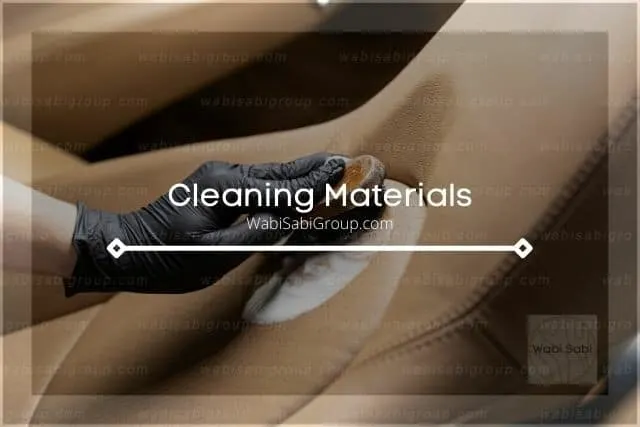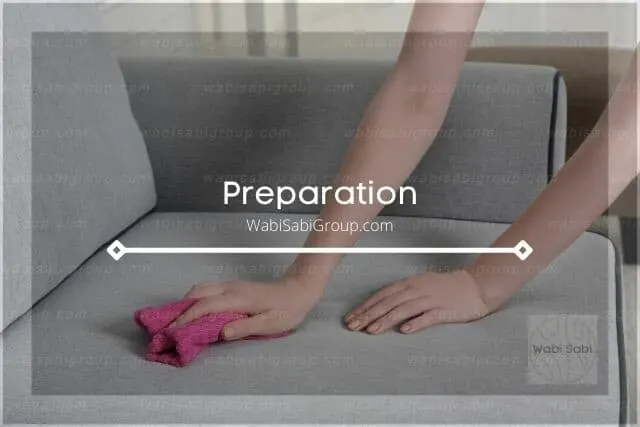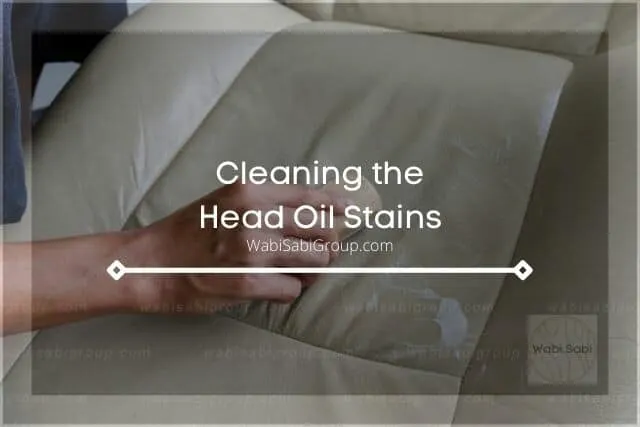Are you struggling to remove head oil stains from your upholstery? Whether it’s from resting your head on the couch or from your hair touching the back of the seat, head oil stains can be unsightly and difficult to remove. Fortunately, there are several methods you can try to get rid of these stubborn stains and restore your upholstery to its former glory.

One popular method is to use baking soda. Sprinkling baking soda over the affected area and allowing it to sit overnight can help absorb the oil and accompanying odor. Vacuuming up the baking soda the next day can help remove the stain. Another option is to mix warm water and ammonia together, along with a small amount of laundry or dish detergent, and apply the mixture to the stain. Agitating the mixture with a cloth or sponge can help break up the oil and lift the stain from the upholstery.
Cleaning Materials

When it comes to cleaning head oil from upholstery, there are several materials you can use. In this section, we will discuss some of the most effective cleaning materials that you can use to clean head oil from your upholstery.
Upholstery Cleaner
One of the best materials you can use to clean head oil from your upholstery is an upholstery cleaner. These cleaners are specifically designed to remove stains and dirt from upholstery. They come in various forms, including sprays, foams, and liquids.
To use an upholstery cleaner, simply follow the instructions on the label. Usually, you will need to spray the cleaner onto the affected area, let it sit for a few minutes, and then wipe it away with a clean cloth.
White Vinegar
White vinegar is another effective material for cleaning head oil from upholstery. It is a natural cleaning agent that can break down grease and oil.
To use white vinegar, mix equal parts water and vinegar in a spray bottle. Spray the solution onto the affected area and let it sit for a few minutes. Then, blot the area with a clean cloth until the stain is removed.
Baking Soda
Baking soda is a versatile material that can be used for many cleaning tasks, including removing head oil from upholstery. It is a natural abrasive that can break down stains and odors.
To use baking soda, sprinkle a generous amount onto the affected area and let it sit for a few minutes. Then, use a damp cloth to scrub the area until the stain is removed.
Water
Water is a simple, yet effective material for cleaning head oil from upholstery. It can be used alone or in combination with other materials, such as vinegar or baking soda.
To use water, simply dampen a clean cloth with water and blot the affected area until the stain is removed.
In conclusion, there are several effective materials you can use to clean head oil from upholstery. Upholstery cleaner, white vinegar, baking soda, and water are all great options that can help you remove stains and restore the look of your upholstery.
Preparation

Before you start cleaning head oil from your upholstery, there are a few things you should do to prepare. This will help ensure that you don’t damage the fabric, and that the cleaning process is as effective as possible.
Vacuuming the Upholstery
The first step in preparing to clean head oil from your upholstery is to vacuum the fabric thoroughly. This will remove any loose dirt, dust, and debris from the surface of the upholstery, which will make it easier to clean the oil stain.
When vacuuming your upholstery, be sure to use the upholstery attachment on your vacuum cleaner. This attachment is specifically designed for cleaning upholstery, and will help prevent damage to the fabric.
Spot Testing
Before you start cleaning the head oil stain from your upholstery, it’s important to do a spot test to make sure that the cleaning solution you’re using won’t damage the fabric.
To do a spot test, simply apply a small amount of the cleaning solution to an inconspicuous area of the upholstery, such as the back or underside of the fabric. Wait a few minutes, then blot the area with a clean white cloth. If the fabric appears to be undamaged, you can proceed with cleaning the head oil stain.
If the fabric does appear to be damaged, stop immediately and try a different cleaning solution. It’s better to be safe than sorry when it comes to cleaning upholstery, as some fabrics are more delicate than others.
This content is owned by Wabi Sabi Group and was first published on May 25, 2023..
By vacuuming the upholstery and doing a spot test, you’ll be well-prepared to clean head oil from your upholstery effectively and safely.
Cleaning the Head Oil Stains

If you have head oil stains on your upholstery, don’t worry. You can clean them with some simple DIY methods. Here are some ways to clean head oil stains from upholstery:
Using Upholstery Cleaner
Upholstery cleaner is a great way to clean head oil stains from upholstery. Here is how you can use it:
- Apply the upholstery cleaner to the head oil stain.
- Let it sit for a few minutes.
- Scrub the stain with a soft-bristled brush.
- Wipe the area with a clean, damp cloth.
- Let it air dry.
Using White Vinegar
White vinegar is another effective way to clean head oil stains from upholstery. Here is how you can use it:
- Mix equal parts of white vinegar and water in a spray bottle.
- Spray the solution onto the head oil stain.
- Let it sit for a few minutes.
- Scrub the stain with a soft-bristled brush.
- Wipe the area with a clean, damp cloth.
- Let it air dry.
Using Baking Soda
Baking soda is a natural cleaner that can help remove head oil stains from upholstery. Here is how you can use it:
- Sprinkle baking soda over the head oil stain.
- Let it sit for a few hours or overnight.
- Vacuum the baking soda from the upholstery.
- Mix equal parts of white vinegar and water in a spray bottle.
- Spray the solution onto the head oil stain.
- Let it sit for a few minutes.
- Scrub the stain with a soft-bristled brush.
- Wipe the area with a clean, damp cloth.
- Let it air dry.
In conclusion, cleaning head oil stains from upholstery is easy and can be done with simple DIY methods. You can use upholstery cleaner, white vinegar, or baking soda to clean head oil stains from upholstery. Just follow the instructions carefully and be patient. With a little effort, you can make your upholstery look like new again.
Drying the Upholstery

After cleaning the head oil from your upholstery, it’s essential to dry the area thoroughly to prevent mold and mildew growth. Here are some tips for drying your upholstery:
- Use a clean, dry towel: After cleaning the area, use a clean, dry towel to blot the excess moisture. Do not rub the area, as it can damage the fabric.
- Air dry: Allow the upholstery to air dry naturally. Open the windows or turn on a fan to help circulate the air and speed up the drying process.
- Avoid heat: Do not use a hairdryer or any other heat source to dry the upholstery. Heat can damage the fabric and cause it to shrink or warp.
- Use a dehumidifier: If the area is particularly humid, you can use a dehumidifier to help remove excess moisture from the air. This can speed up the drying process and prevent mold growth.
- Check for dampness: Once the upholstery is dry, check for any dampness. If you notice any dampness, repeat the drying process until the area is completely dry.
By following these tips, you can effectively dry your upholstery and prevent any further damage.
Preventing Head Oil Stains

If you want to avoid head oil stains on your upholstery, there are a few things that you can do to prevent them. Here are some tips:
Using a Headrest Cover
One of the best ways to prevent head oil stains is to use a headrest cover. This is especially useful if you have leather or vinyl upholstery, which is more prone to staining. A headrest cover can protect the upholstery from oils, sweat, and dirt. You can easily remove and wash the cover to keep it clean.
This article was first published on May 25, 2023 by Wabi Sabi Group..
Regular Cleaning
Another way to prevent head oil stains is to clean your upholstery regularly. Regular cleaning can prevent the buildup of oils and dirt, which can lead to stains. Here are some tips for cleaning your upholstery:
- Vacuum your upholstery regularly to remove dust and dirt.
- Use a mild detergent and water to clean your upholstery. Avoid using harsh chemicals that can damage the fabric.
- Test any cleaning product on a small, inconspicuous area before using it on the entire upholstery.
- Blot spills immediately with a clean, dry cloth to prevent them from setting in.
By using a headrest cover and cleaning your upholstery regularly, you can prevent head oil stains and keep your upholstery looking clean and fresh.
Related Articles
Can You Remove Sweat Stains From Leather?
Can You Remove Ink Stains From Leather?
Can You Remove Grease Stains From Leather? (How To)
WabiSabi Group is the owner of this article and was published on May 25, 2023 and last modified on .
